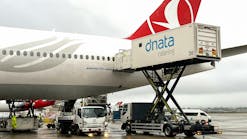Lack of Driver Training for Airside Equipment Could Compromise Safety
Each flight involves large numbers of support staff, including handling agents, ground crew, flight crew, passengers and radio operators, as well as vehicles. The sheer number of people involved in each movement, combined with time pressures, changeable weather conditions and the ‘human factor,’ present potentially serious risks to safety.
“To truly reduce risk, it is vitally important for employers of ground handlers to understand what is, and isn’t, covered by the Airside Driver Permit (ADP) training and deliver the necessary training to their staff,” explains Laura Nelson, managing director of RTITB.
“The ADP requires the operator to have a Category B driving license, so many employers wrongly assume that as long as an operator has done ADP training, they will be able to drive any type of airside equipment skilfully and safely,” continues Nelson. “That is simply not the case.”
CAP790 offers guidance
Vehicle operation on the ground airside has many safety implications. Vehicles invariably come into proximity of ground staff, passengers, other employees and, of course, aircraft. Operations must therefore consider Health and Safety Executive (HSE) regulations such as PUWER* and Health and Safety (Safety Signs and Signals) Regulations 1996, as well as various workplace transport safety regulations.
Recommendations set out by the Civil Aviation Authority (CAA) for aerodromes and third parties (such as handling agents) must also be considered.
To help aerodromes, and employers of staff at aerodromes, meet safety obligations in line with European Aviation Safety Agency (EASA) regulations, including safe driving operations, the CAA has produced various Civil Aviation Publications (CAPs) offering guidance.
The document ‘CAP790: Requirement for an Airside Driving Permit (ADP) Scheme’ provides useful guidance for ground support operations on how to comply with European Aviation Safety Agency (EASA) regulations and a framework for best practice. It illustrates how risks might be identified and provides advice on integrating airside driving safety into a Safety Management System (SMS).
CAP790 was introduced to help reduce the risks related to vehicle operations in the airside environment by providing clear guidance on what those responsible for airside vehicle movements should consider regarding ground support equipment movements in different areas of an airfield. It also covers the issuing of permits, and the retention of permits.
“Because of the overlap with air operations, the ADP is one of the most important safety mechanisms within the airside environment, helping to align all parties involved with ground vehicle operations and reduce risk,” Nelson explains. “However, the ADP training is only part of the airside safety story.”
ADP does not cover equipment training
ADP training is weighted towards the specifics of the airfield and workplace familiarization due to the complexities of vehicle operation, combined with specific airfield safety protocols. Dependent on the ADP training completed, operators will be issued with permits that allow them to drive on certain areas of the airfield, for example ‘A’ permits are for airside roads and the apron and ‘M’ permits are for manoeuvring areas. ‘R’ permits are for the runway and can only be obtained once an ‘M’ permit has been acquired.
However, at no level does ADP training focus on driving itself. Therefore, acquisition of an ADP does not automatically enable operators to use the multitude of equipment types found airside. In fact, CAP790 states that training is required in accordance with DVLA or industry standards for the equipment that operators will be required to use. This includes training on safely operating baggage tugs, de-icers, re-fuellers, waste removal lorries, bowsers, emergency incident vehicles, beltloaders, hi-loaders, sweepers, tractors, prime movers and airbridges.
As well as promoting the importance of training, CAP790 also offers helpful guidance on managing driver behaviour and ultimately the revocation of permits if offences are serious enough, or if too many offences are accrued. In line with CAP642**, driver management should form part of the aerodrome’s overall Safety Management System and is therefore also integral to meeting ADP requirements.
Who is responsible for safety?
Responsibility to ensure airside operation safety to CAA recommendations, and other relevant Health and Safety legislation, ultimately lies with the aerodrome authority. However, all employers operating within the site, including ground handling agents and other parties working with ground support equipment, also have responsibility to comply with the aerodrome authority’s rules, to meet their commitment to safety.
“Designed to ensure compliance and improve safety and efficiency on the airfield, CAP790 aims to help all parties in and around the airfield achieve a less reactive and more proactive approach to the supervision and management of drivers,” says Nelson. “However, to achieve optimal airside safety, employers need to understand the important difference between complying with ADP requirements and delivering equipment operator training.”
RTITB’s expert aviation team specializes in supporting airports and ground handling companies to maximize safety and reduce costs in ground operations. All RTITB training courses are designed to help companies comply with local laws and regulations and the international requirements of EASA, as well as to improve the standards of ground support equipment operator training. Instructor training enables companies to deliver RTITB training in-house for their ground support staff.
For advice on delivering ground support equipment training in line with CAP790 guidelines, visit www.rtitb.co.uk/aviation or call the aviation team specialists on +44(0)1952 520207.
*Provision and Use of Work Equipment Regulations 1998
**CAP642: Airside Safety Management




